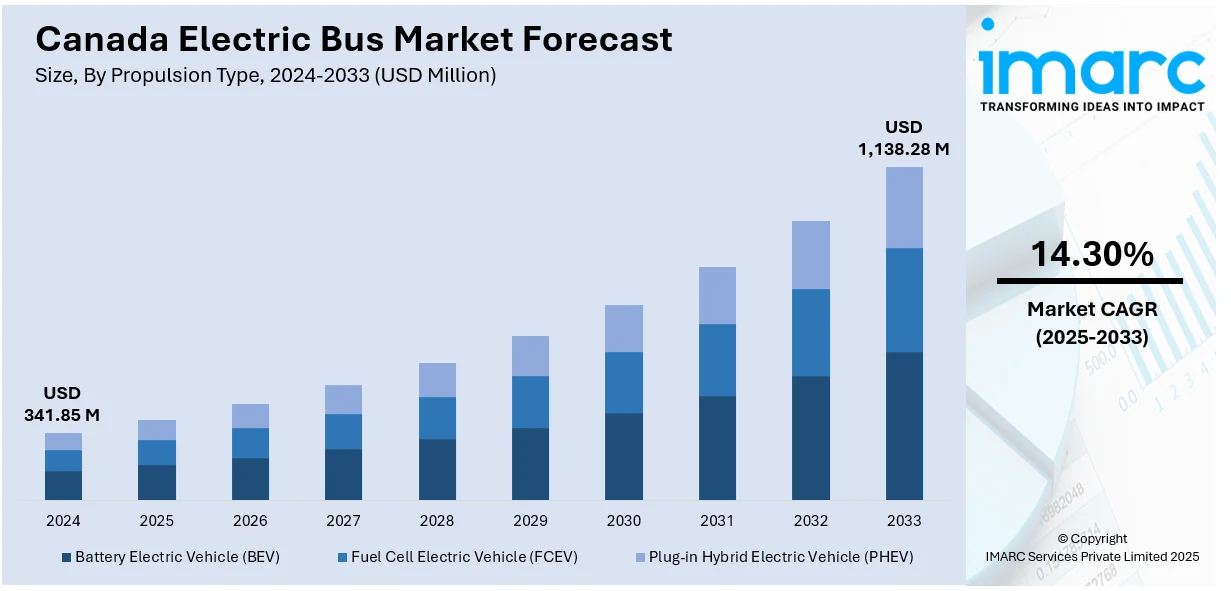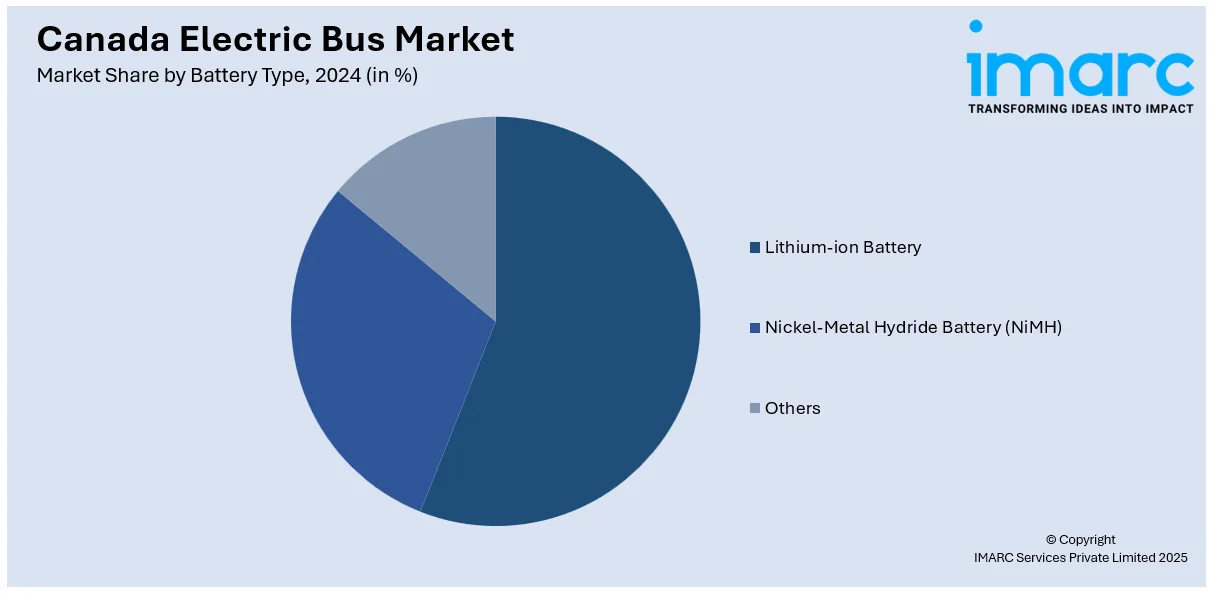
Canada Electric Bus Market Size, Share, Trends and Forecast by Propulsion Type, Battery Type, Length, Range, Battery Capacity, and Region, 2025-2033
Canada Electric Bus Market Size and Share:
The Canada electric bus market size reached USD 341.85 Million in 2024. Looking forward, IMARC Group expects the market to reach USD 1,138.28 Million by 2033, exhibiting a growth rate (CAGR) of 14.30% during 2025-2033. The market is propelled by the environmental sustainability goals, significant technological advancements in battery systems, favorable government policies and subsidies, rising urbanization and public transit demand, declining costs of electric buses, and corporate sustainability initiatives thus aiding the Canada electric bus market share.
|
Report Attribute
|
Key Statistics
|
|---|---|
|
Base Year
|
2024
|
|
Forecast Years
|
2025-2033
|
|
Historical Years
|
2019-2024
|
| Market Size in 2024 | USD 341.85 Million |
| Market Forecast in 2033 | USD 1,138.28 Million |
| Market Growth Rate (2025-2033) | 14.30% |
Canada electric bus Market Analysis:
- Major Drivers: Strong environmental policies, supportive federal and provincial incentives, long‑term cost savings, and increasing public demand for sustainable transportation are major forces driving the rapid shift toward electrification in Canada’s bus sector.
- Key Market Trends: Canada’s electric bus market is evolving toward zero‑emission fleets, with battery‑electric buses leading adoption, increasing interest in hydrogen fuel‑cell options, and growing collaboration between governments and manufacturers to meet sustainability goals are some of the key Canada electric bus market trends.
- Market Opportunities: Significant opportunities lie in expanding charging infrastructure, government funding programs, and school and public transit fleet transitions, encouraging local manufacturing, innovative partnerships, and accelerated adoption of zero‑emission technologies across provinces.
- Market Challenges: The sector faces high upfront costs, uneven charging network development, grid capacity concerns, operational issues in extreme climates, and maintenance complexities, which slow adoption and create uncertainty for fleet operators in the Canada electric bus market analysis.
Canada Electric Bus Market Trends:
Growing Environmental Awareness and Sustainability Goals
An important driver of the electric bus market in Canada is the increasing public awareness about environmental issues and sustainability goals. Due to rising concerns about air pollution and its impact on public health, there is an increasing need for cleaner and more sustainable public transportation options. According to the Canadian Lung Association, more than 3,000 Canadians get exposed to radon exposure and more than 15,000 of them die due to air pollution. Electric buses, viewed as a pivotal technology for enhancing air quality, particularly in cities suffering from increased pollution due to traffic congestion, emit no tailpipe emissions. Cities in Canada such as Toronto and Vancouver have quickly embraced electric buses, driven by a combination of citizen demand for more environmentally friendly transport choices and the goals of the cities to decrease carbon emissions. In order to achieve emission reduction goals, transit agencies are incorporating electric buses into their vehicle lineup as part of a larger push toward sustainability.

To get more information on this market, Request Sample
Rapid Urbanization and Increasing Public Transit Demand
The increase in urbanization and the rising need for effective public transportation systems are important factors propelling the Canada electric bus market demand. As per the Data World Bank, as of 2023, 82% of individuals in Canada reside in urban areas. As the population of Canada continues to grow steadily, particularly in urban areas, cities are under growing pressure to enhance and expand their public transportation systems. Conventional diesel buses play a major role in causing air pollution, traffic jams, and noise pollution in crowded urban areas, leading to adverse effects on public health and overall well-being. In response, local governments are seeking cleaner, quieter, and more sustainable transportation options, with electric buses gaining popularity. Electric buses provide a variety of benefits for city public transportation systems. Operating quietly, they decrease noise pollution, especially in residential locations, while their emission-free characteristic aids in decreasing greenhouse gas emissions and particulate matter in urban settings.
Advancements in Battery Technology
Advances in battery technology drive the Canada electric bus market growth. Upgrades in the life of the battery, availability of charging stations, and size of the battery have led to the viability of electric buses for public transport. For instance, in July 2024, the Government of Canada announced a $10.15 million investment for Dalhousie University's Canadian Battery Innovation Centre, aimed at advancing battery technology and production. This initiative will enhance training for skilled personnel and strengthen Canada’s position in the electric vehicle supply chain, contributing to a net-zero economy and job creation. Electric buses usually use lithium-ion batteries, which have witnessed a tremendous increase in energy density capacity, enabling these buses to cover larger distances on a single charge. The installation of rapid charging stations and the upgrading of battery management systems further diminishes the charging time for electric buses, further giving them an edge toward viability for transportation services. Technological changes also bring down the total cost of ownership of electric buses through long battery life and lower maintenance costs, as there are fewer mechanical parts than in any conventional bus.
Canada Electric Bus Market Segmentation:
IMARC Group provides an analysis of the key trends in each segment of the market, along with forecasts at the regional level for 2025-2033. Our report has categorized the market based on propulsion type, battery type, length, range and battery capacity.
Propulsion Type Insights:
- Battery Electric Vehicle (BEV)
- Fuel Cell Electric Vehicle (FCEV)
- Plug-in Hybrid Electric Vehicle (PHEV)
The report has provided a detailed breakup and analysis of the market based on the propulsion type. This includes battery electric vehicle (BEV), fuel cell electric vehicle (FCEV) and plug-in hybrid electric vehicle (PHEV).
Battery Type Insights:

- Lithium-ion Battery
- Nickel-Metal Hydride Battery (NiMH)
- Others
A detailed breakup and analysis of the market based on the battery type have also been provided in the report. This includes lithium-ion battery, nickel-metal hydride battery (NiMH) and others.
Length Insights:
- Less than 9 Meters
- 9-14 Meters
- Above 14 Meters
A detailed breakup and analysis of the market based on the length have also been provided in the report. This includes less than 9 meters, 9-14 meters and above 14 meters.
Range Insights:
- Less than 200 Miles
- More than 200 Miles
A detailed breakup and analysis of the market based on the range have also been provided in the report. This includes less than 200 miles and more than 200 miles.
Battery Capacity Insights:
- Up to 400 kWh
- Above 400 kWh
A detailed breakup and analysis of the market based on the battery capacity have also been provided in the report. This includes up to 400 kWh and above 400 kWh.
Regional Insights:
- Ontario
- Quebec
- Alberta
- British Columbia
- Others
The report has also provided a comprehensive analysis of all the major regional markets, which include Ontario, Quebec, Alberta, British Columbia and others.
Competitive Landscape:
The market research report has also provided a comprehensive analysis of the competitive landscape. Competitive analysis such as market structure, key player positioning, top winning strategies, competitive dashboard, and company evaluation quadrant has been covered in the report. Also, detailed profiles of all major companies have been provided.
Canada Electric Bus Market News:
- In February 2025, Winnipeg Transit launched its first zero-emission hydrogen fuel-cell battery electric bus, part of an order for 16 zero-emission vehicles expected by spring. This initiative follows the city’s past pilot project with battery-electric buses and aims to assess winter performance. Limited service for these buses is set to begin in April.
- In September 2024, the TTC in Toronto is set to have the largest battery-electric bus fleet in North America by 2026, due to a joint $700 million investment from the City of Toronto and the federal government. The new battery-electric buses, part of the transition of TTC to 100% zero emissions by 2040, have improved battery capacity and are more accessible, contributing to a greener public transit system.
Canada Electric Bus Market Report Coverage:
| Report Features | Details |
|---|---|
| Base Year of the Analysis | 2024 |
| Historical Period | 2019-2024 |
| Forecast Period | 2025-2033 |
| Units | Million USD |
| Scope of the Report |
Exploration of Historical Trends and Market Outlook, Industry Catalysts and Challenges, Segment-Wise Historical and Future Market Assessment:
|
| Propulsion Types Covered | Battery Electric Vehicle (BEV), Fuel Cell Electric Vehicle (FCEV), Plug-in Hybrid Electric Vehicle (PHEV) |
| Battery Types Covered | Lithium-ion Battery, Nickel-Metal Hydride Battery (NiMH), Others |
| Lengths Covered | Less than 9 Meters, 9-14 Meters, Above 14 Meters |
| Range Covered | Less than 200 Miles, More than 200 Miles |
| Battery Capacities Covered | Up to 400 kWh, Above 400 kWh |
| Regions Covered | Ontario, Quebec, Alberta, British Columbia, Others |
| Customization Scope | 10% Free Customization |
| Post-Sale Analyst Support | 10-12 Weeks |
| Delivery Format | PDF and Excel through Email (We can also provide the editable version of the report in PPT/Word format on special request) |
Key Benefits for Stakeholders:
- IMARC’s industry report offers a comprehensive quantitative analysis of various market segments, historical and current market trends, market forecasts, and dynamics of the Canada electric bus market from 2019-2033.
- The research report provides the latest information on the market drivers, challenges, and opportunities in the Canada electric bus market.
- Porter's five forces analysis assist stakeholders in assessing the impact of new entrants, competitive rivalry, supplier power, buyer power, and the threat of substitution. It helps stakeholders to analyze the level of competition within the Canada electric bus industry and its attractiveness.
- Competitive landscape allows stakeholders to understand their competitive environment and provides an insight into the current positions of key players in the market.
Key Questions Answered in This Report
The electric bus market in the Canada was valued at USD 341.85 Million in 2024.
The Canada electric bus market is projected to exhibit a CAGR of 14.30% during 2025-2033, reaching a value of USD 1,138.28 Million by 2033.
Canada’s electric bus market is driven by strong government incentives, strict emissions regulations, and commitments to sustainable transport. Expanding charging networks, growing public demand for cleaner transit, operational cost savings, and support for local manufacturing further accelerate adoption, making electrification a priority for public and school transportation systems nationwide.
Need more help?
- Speak to our experienced analysts for insights on the current market scenarios.
- Include additional segments and countries to customize the report as per your requirement.
- Gain an unparalleled competitive advantage in your domain by understanding how to utilize the report and positively impacting your operations and revenue.
- For further assistance, please connect with our analysts.
 Request Customization
Request Customization
 Speak to an Analyst
Speak to an Analyst
 Request Brochure
Request Brochure
 Inquire Before Buying
Inquire Before Buying




.webp)




.webp)












